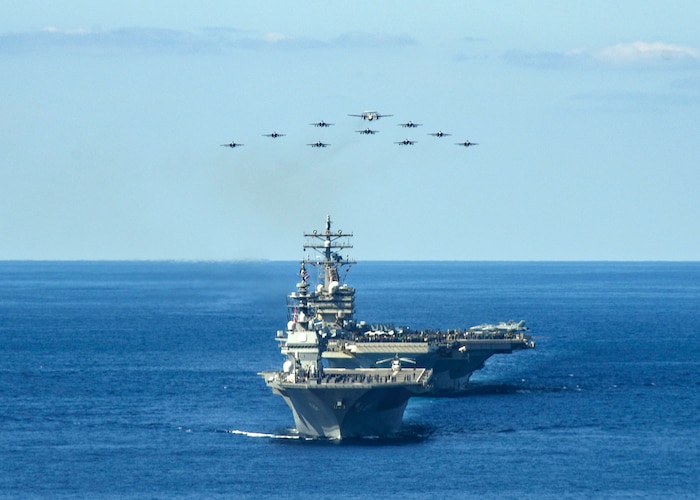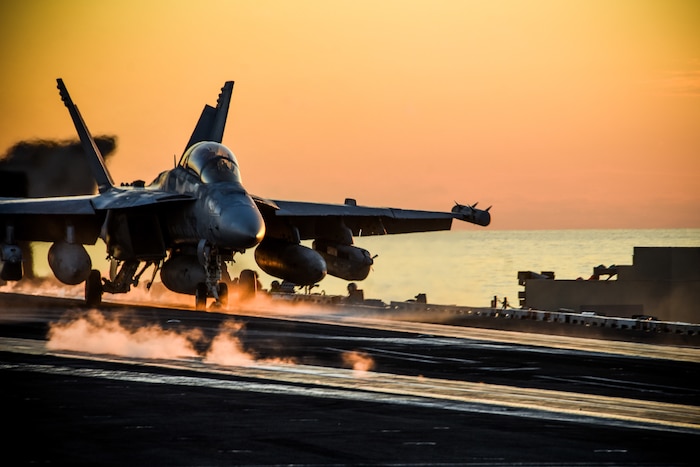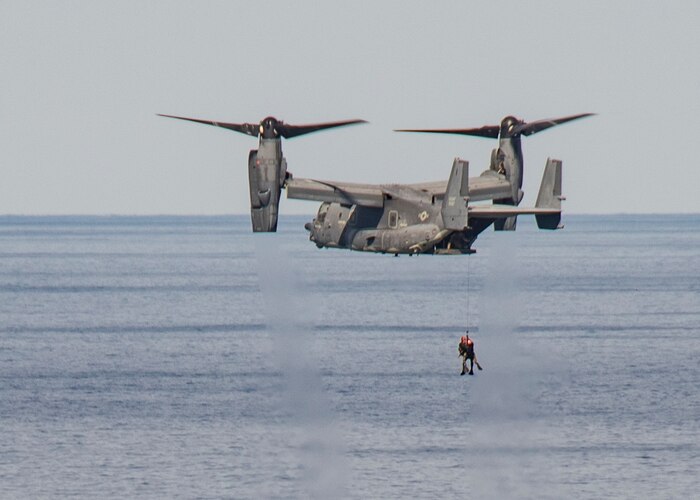PEARL HARBOR -- PEARL HARBOR - Units attached to U.S. Indo-Pacific Command (INDOPACOM) and the Japan Self-Defense Force completed exercise Keen Sword 21 (KS21), Nov. 5, on military installations throughout mainland Japan, Okinawa prefecture, and their surrounding waters.

201026-N-YQ181-1341
U.S. Navy ships assigned to Ronald Reagan Carrier Strike Group joined ships of Japan Maritime Self-Defense Force (JMSDF) Escort Flotilla 1, Escort Flotilla 4, and the Royal Canadian Navy, in formation while aircraft from the U.S. Navy, U.S. Marine Corps, U.S. Air Force, JMSDF and Japan Air Self Defense Force fly in formation during Keen Sword 21. Keen Sword is an example of the strength of U.S.-Japan Alliance, the foundation of peace and security in the Indo-Pacific region for almost 60 years. The relationships built and maintained during these events are critical to our shared capability to respond to contingencies at a moment’s notice. (U.S. Navy photo by Mass Communication Specialist Seaman Askia Collins)
1 of 6

201026-N-DL524-1446
201026-N-DL524-1446 PHILIPPINE SEA (Oct. 26, 2020) U.S. Navy ships assigned to Ronald Reagan Carrier Strike Group joined ships of Japan Maritime Self-Defense Force (JMSDF) Escort Flotilla 1, Escort Flotilla 4, and the Royal Canadian Navy, in formation while aircraft from the U.S. Navy, U.S. Marine Corps, U.S. Air Force, JMSDF and Japan Air Self Defense Force fly in formation during Keen Sword 21. Keen Sword is an example of the strength of U.S.-Japan Alliance, the foundation of peace and security in the Indo-Pacific region for almost 60 years. The relationships built and maintained during these events are critical to our shared capability to respond to contingencies at a moment’s notice. (U.S. Navy photo by Mass Communication Specialist 2nd Class Erica Bechard)
2 of 6

201026-N-NK931-615
PHILIPPINE SEA (Oct. 26, 2020) U.S. Navy ships assigned to the Ronald Reagan Carrier Strike Group joined ships of the Japan Maritime Self-Defense Force (JMSDF) Escort Flotilla 1, Escort Flotilla 4, and the Royal Canadian Navy in formation while aircraft from the U.S. Navy, U.S. Marine Corps, U.S. Air Force, JMSDF and Japan Air Self-Defense Force fly in formation during Keen Sword 21. Keen Sword is an example of the strength of the U.S.-Japan Alliance, the foundation of peace and security in the Indo-Pacific region for more than 60 years. The relationships built and maintained during these events are critical to our shared capability to respond to contingencies at a moment's notice. (U.S. Navy photo by Lt. j.g Samuel Hardgrove)
3 of 6

201028-N-ZF088-1138
PHILIPPINE SEA (Oct. 28, 2020) An EA-18G Growler attached to the Shadowhawks of Electronic Attack Squadron (VAQ) 141 takes off from the flight deck of the Navy’s only forward-deployed aircraft carrier USS Ronald Reagan (CVN 76) during Keen Sword 21. Keen Sword is an example of the strength of U.S.-Japan Alliance, the foundation of peace and security in the Indo-Pacific region for almost 60 years. The relationships built and maintained during these events are critical to our shared capability to respond to contingencies at a moment’s notice. (U.S. Navy photo by Mass Communication Specialist 3rd Class Gabriel A. Martinez)
4 of 6

201028-N-DL524-1120
PHILIPPINE SEA (Oct. 28, 2020) A U.S. Air Force CV-22 Osprey, attached to the 21st Special Operations Squadron operating out of Yokota Air Base, Japan, conducts a search-and-rescue exercise in conjunction with the Navy’s only forward-deployed aircraft carrier USS Ronald Reagan (CVN 76) during Keen Sword 21. Keen Sword is an example of the strength of U.S.-Japan Alliance, the foundation of peace and security in the Indo-Pacific region for more than 60 years. The relationships built and maintained during these events are critical to our shared capability to respond to contingencies at a moment’s notice. (U.S. Navy photo by Mass Communication Specialist 2nd Class Erica Bechard)
5 of 6

201026-N-NK931-221
PHILIPPINE SEA (Oct. 26, 2020) The Arleigh Burke-class guided-missile destroyer USS Barry (DDG 52) breaks away following an underway replenishment with the Japan Maritime Self Defense Force (JMSDF) Mashu-class replenishment ship JS Mashu (AOE 425) during exercise Keen Sword 21. Keen Sword is an example of the strength of the U.S.-Japan Alliance, the foundation of peace and security in the Indo-Pacific region for more than 60 years. The relationships built and maintained during these events are critical to our shared capability to respond to contingencies at a moment's notice. (U.S. Navy photo by Lt. j.g Samuel Hardgrove)
6 of 6
The joint-bilateral field training exercise (FTX), including forces from the U.S. Navy, Air Force, Army, and Marine Corps, enhanced Japan-U.S. combat readiness and interoperability. The FTX included maritime operations, amphibious landings, air operations, resupply efforts, integrated air and missile defense (IAMD) exercises, cyber and space operations, and base security events.
“Keen Sword was a tremendous success with respect to operating and integrating with our allies," said Lt. Gen. Kevin Schneider, commander, U.S. Forces Japan. "By learning from and working alongside each other, not only did we improve our joint and bilateral capabilities, we once again demonstrated our unwavering resolve to the U.S.-Japan Alliance, which has been the foundation of peace, stability, and security in the Indo-Pacific region for the past 60 years.”
Approximately 9,000 U.S. and 37,000 JSDF forces trained in the 11-day exercise. Forces under U.S. command included ships from the Ronald Reagan Carrier Strike Group and Commander Task Force 73, USS Ashland (LSD 48), HMCS Winnipeg (FFH 338); aircraft from Carrier Air Wing 5, Commander Task Force 72, 5th Air Force; ground forces from U.S. Army Japan; and air, as well as ground forces from III Marine Expeditionary Force.
At Yokota Air Base, west of Tokyo, the bilateral exercise control group (BECG) coordinated and monitored events throughout KS21. While some events were conducted unilaterally for unit-level training, major portions of the exercise focused on integration, demonstrating the inherent flexibility and capability of the U.S. and Japanese militaries.
“Exercises such as Keen Sword provide the opportunity to enhance our joint-bilateral capabilities, particularly by identifying and then overcoming obstacles through realistic and challenging training scenarios,” said Capt. Naochika Fujiwara, Japan Joint Staff director of training and exercises, and BECG co-director. “Even more, Keen Sword provided a message that our Japan-U.S. Alliance continues to be a cornerstone of regional peace and security.”
The BECG focused on highlighting cross and multi-domain operations as well as finding new initiatives, which are all critical to the shared capability to respond to contingencies at a moment’s notice.
“U.S. and Japanese forces already have a long history of training together, and we value every opportunity to seize new initiatives that will build upon our existing proficiencies,” said U.S. Army Col. Jeffrey Gottlieb, U.S. Indo-Pacific Command acting deputy director for training and exercises, and BECG co-director. “These continual enhancements set up future iterations of Keen Sword for more challenges and successes, and more broadly, ensure a free and open Indo-Pacific.”
Keen Sword 21 was a biennial, Chairman of the Joint Chiefs of Staff-directed, U.S. Indo-Pacific Command-scheduled, and U.S. Pacific Fleet-sponsored FTX. The joint-bilateral FTX ran from Oct. 26 through Nov. 5.
For more information on Keen Sword, please visit the Keen Sword DVIDS feature page. Questions regarding JSDF training and personnel should be referred to Japan Joint Staff Office Public Affairs at +81-3-3268-3111 ext. 30056.